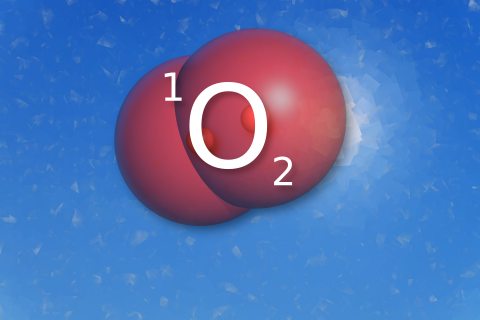The Road Less Travelled: new horizons on the (patho)-physiological function for singlet oxygen (¹O₂) in mammals

Redoxoma Highlights by Paolo Di Mascio
Corresponding author e-mail: pdmascio@iq.usp.br
Singlet oxygen (1O2) is a biologically relevant reactive oxygen species capable of efficiently reacting with cellular constituents. Although it has usually received less attention than other free radical or non free-radical oxidants, the main oxidation reactions initiated by 1O2 and the resulting modifications within key cellular targets, including guanine for nucleic acids, unsaturated lipids, and targeted amino acids are increasingly evident and have been described in a recent publication [1]. Most of these reactions give rise to peroxides and dioxetanes, whose formation has been rationalized in terms of [4+2] cycloaddition and 1,2-cycloaddition with dienes + olefins, respectively [1].
Ultraweak chemiluminescence arising from biomolecules oxidation has been attributed to the radioative deactivation of 1O2 and electronically excited triplet carbonyl products involving dioxetane intermediates. As examples, the generation of 1O2 from lipid hydroperoxides, which involves a cyclic mechanism from a linear tetraoxide intermediate. Also, the generation of 1O2 via energy transfer from the excited triplet acetone arising from the thermodecomposition of dioxetane is a chemical source, and horseradish peroxidase-catalyzed oxidation of 2-methylpropanal is an enzymatic source [2].
Recently Stanley and colleagues described a possible pathophysiological role for 1O2 in mammals, through formation of an amino acid-derived hydroperoxide that regulates vascular tone and blood pressure under inflammatory conditions [3,4].
Chemically generated 1O2 oxidizes the amino acid tryptophan (W) to precursors of a key metabolite called N-formylkynurenine (NFK), while enzymatic oxidation of W to NFK is catalyzed by a family of dioxygenases, including indoleamine 2,3-dioxygenase 1 (IDO1). Inflammation is associated with increased H2O2 and IDO1 also possesses peroxidase activity. Tryptophan oxidation by IDO1 in the presence of H2O2 revealed that cis-WOOH (a tricyclic triptophan-derived cis-hydroperoxide) is formed as the major product of a previously unrecognized oxidatively activated dioxygenase activity of IDO1. cis-WOOH is a precursor of NFK and the thermal decomposition of cis-WOOH also led to emission of light, characteristic of activated carbonyls [3–5]. The cis-WOOH acts as a hitherto undiscovered signaling molecule in vivo, which induces arterial relaxation and decreases blood pressure dependent on cysteine residue 42 of protein kinase (PK) G1. The IDO1/PKG1 axis can be a possible therapeutic target in sepsis, where oxidative activation of PKG1 and IDO1 activity are prevalent. Another possibility is that the reactive and potentially cytotoxic 1O2 may contribute to IDO1-mediated immune tolerance and tumor evasion, with inhibition of IDO1 representing a major target of anti-cancer drug development.
The approach used to unequivocally demonstrate the generation of 1O2 in these reactions is the use of 18O-labeled peroxides / triplet dioxygen (18[3O2]), the detection of labeled compounds by HPLC coupled to mass spectrometry (HPLC-MSn) and the direct spectroscopic detection and characterization of 1O2 light emission. Characteristic light emission at 1,270 nm, corresponding to the singlet delta state monomolecular decay was observed. Using 18[3O2], we observed the formation of 18O-labeled 1O2 (18[1O2]) by the chemical trapping of 18[1O2] with the anthracene-9,10-diyldiethane-2,1-diyl disulfate disodium salt (EAS) and detected the corresponding 18O-labeled EAS endoperoxide using HPLC-MS/MS [1].
The reactivity of 1O2 with biomolecules, as amino acids or lipids, may generate specific stereoselective oxidation products [1]. The elucidation of these structures and their specific targets can give important information and new horizons on the (patho)-physiological function for 1O2 in mammals via formation of signaling molecules.
References
- P. Di Mascio, G. R. Martinez, S. Miyamoto, G. E. Ronsein, M. H. G. Medeiros, J. Cadet. Singlet Molecular Oxygen Reactions with Nucleic Acids, Lipids, and Proteins Chemical Reviews, 119(3): 2043–86, 2019. | doi: 10.1021/acs.chemrev.8b00554
- C. M. Mano, F. M. Prado, J. Massari, G. E. Ronsein, G. R. Martinez, S. Miyamoto, J. Cadet, H. Sies, M. H. G. Medeiros, E. J. H. Bechara, et al.. Excited singlet molecular O2 (¹Δg) is generated enzymatically from excited carbonyls in the dark Scientific Reports, 4(1): 2014. | doi: 10.1038/srep05938
- G. E. Ronsein, M. C. B. Oliveira, S. Miyamoto, M. H. G. Medeiros, P. Di Mascio. Tryptophan Oxidation by Singlet Molecular Oxygen [O2(¹Δg)]: Mechanistic Studies Using18O-Labeled Hydroperoxides, Mass Spectrometry, and Light Emission Measurements Chemical Research in Toxicology, 21(6): 1271–83, 2008. | doi: 10.1021/tx800026g
- C. P. Stanley, G. J. Maghzal, A. Ayer, J. Talib, A. M. Giltrap, S. Shengule, K. Wolhuter, Y. Wang, P. Chadha, C. Suarna, et al.. Singlet molecular oxygen regulates vascular tone and blood pressure in inflammation Nature, 566(7745): 548–52, 2019. | doi: 10.1038/s41586-019-0947-3
- D. A. Kass. Fresh evidence overturns the identification of a factor involved in blood-vessel dilation Nature, 566(7745): 462–4, 2019. | doi: 10.1038/d41586-019-00508-z
Paolo Di Mascio, Full Professor at Department of Biochemistry,
Institute of Chemistry, University of São Paulo, Brazil
Add new comment